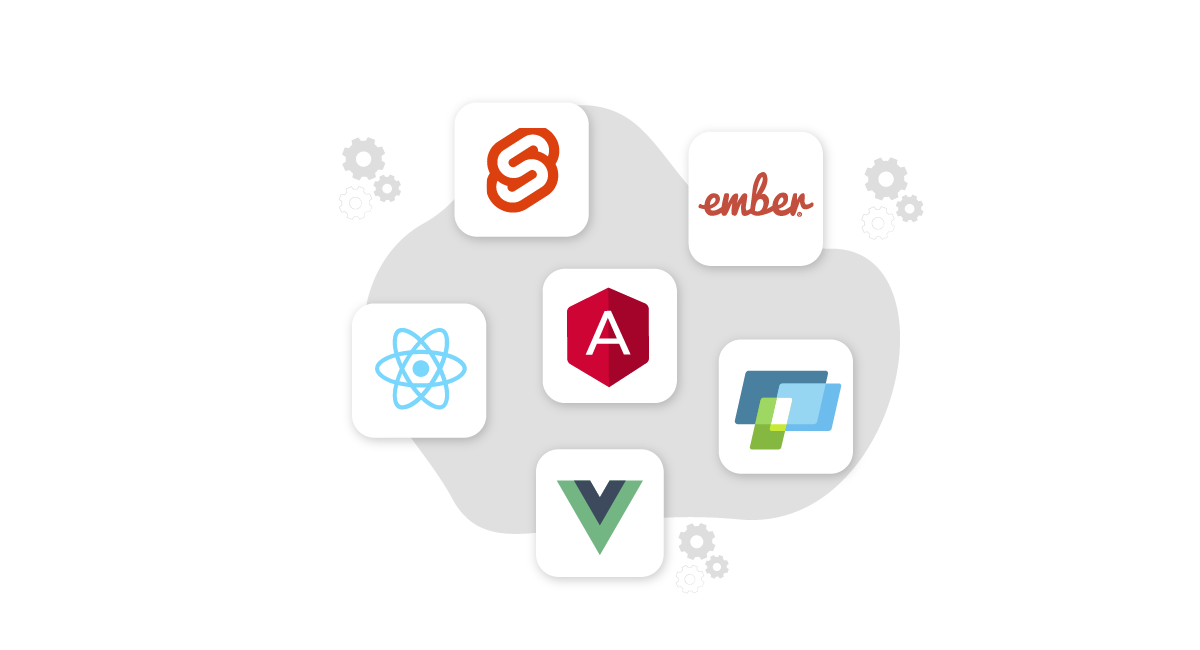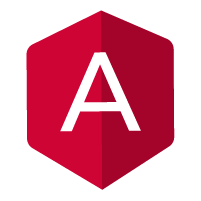Most Popular Frontend Frameworks to Build Scalable Web Apps

With the entire world dealing with the sudden Corona outbreak and working from culture for around a couple of years, the importance of digital transformation and online activities has been growing at an unprecedented rate. People also use several web applications to make their regular tasks easy, and various frontend frameworks have pushed the achievement of all applications and suddenly have picked up steam.
Highlights
- 1 Most Popular Frontend Frameworks to Build Scalable Web Apps
- 1.1 What Are Frontend Frameworks?
- 1.2 Best Frontend Frameworks to Consider in 2023
- 1.3 Benchmark Comparison of Popular Frameworks
- 1.4 Choose The Best Framework To Accelerate The Pace Of Web Development
Before going technical, let’s take an example.
Think of Instagram, Netflix, and Zomato: what is the one thing common in these popular apps?
They all have clean, simple, and aesthetically appealing interfaces that deliver a flawless user experience to their users. And this is the reason why users and downloads of these apps are increasing day by day. So now the question is, how do they create an amazing user experience? The simple answer is frontend frameworks.
Software development today places a great deal of emphasis on user experience. Businesses and developers are finding it difficult to keep up with all the new technologies emerging quickly. A poorly designed user interface may not only create an unsightly appearance but may also drive potential customers away from the company. As a result, businesses are paying more and more attention to frontend development since it enhances user interaction.
Due to the constantly increasing standards of web applications, frameworks have become an essential part of web application development. For such sophisticated techniques, it is absolutely unreasonable to reinvent the wheel, assuming that can be done. It’s, therefore, a very sensible approach to developing rich and interactive web applications to use frameworks supported by thousands of developers worldwide.
We will examine the most popular frontend frameworks in this article and provide you with recommendations for which framework best suits your business needs.
What Are Frontend Frameworks?
Large projects can be developed and maintained more easily with a framework. Programmers can use frameworks to make common programming tasks more accessible, like handling AJAX requests or creating a file structure. A skeleton structure must be extended and changed according to requirements and the rules for developing the app architecture.
The term ‘CSS frameworks’ refers to a package that contains pre-written, homogenous code in folders and files. This allows you to design a site while still affording you flexibility. Frameworks for frontend development are used primarily to create interactive tools and responsive websites.
Among its services is the creation of consistent products that increase traffic and upgrade the appearance and feel of mobile and web applications.
Furthermore, popular UI frameworks have the following advantages:
- Features and applications are reasonably more responsive
- Rapid web app development
- Delivers real-time programming
- Top-notch technology with certain benefits
- Secured and swift
It is fundamental to the software development process to utilize frontend frameworks. In order to create visually appealing apps with a great user experience, there are numerous options to consider. Listed below are the best frontend frameworks for 2023. Let’s examine them in more detail!
Best Frontend Frameworks to Consider in 2023
They advise using the right ingredients to produce the ideal flavor. This is particularly true for companies that want to maintain users’ interest in the solution they create. As a result, attention must be paid to the user interface or UI.
In this digital world, smartphones’ importance is growing as they keep users hooked to the brands they love and ensure long business sustainability. However, users often don’t pay attention to back-end technologies because their focus is on how the app operates, how it looks, and how quickly it allows them to fulfill their tasks. Hence, investing in the best frontend framework is pivotal for businesses.
So without any delay, have a look at the best frontend development frameworks of 2023.
React.js: Zuckerberg’s Brainchild

React, often known as React.js, is now the go-to option for web developers. React has overcome the group’s leader, Angular, as well as upstarts like Vue.js, and more and more people are turning to it now.
Although the outcome of the React vs. Angular battle has not yet been determined, the trend indicates that React will likely prevail in this titanic conflict. ReactJS offers a component-based development methodology and lets you build frontend using JavaScript. Therefore, ReactJS should be your primary pick for frontend development if you are primarily a JavaScript developer.
More than 1.5 million websites have been created with React’s assistance, with more than 3 million active users and an extensive community behind it. In addition, 80% of competent developers have used React successfully in their projects at least once.
Features of React.js
- Secure and stable code
- Virtual DOM
- Enhanced performance and speed
- Faster debugging
- Seamless flexibility across mobile and web
Angular: Google Likes It

The greatest frontend framework for websites is Angular, which currently tops the list. It is a framework for making sophisticated single-page applications that are effective. It is a Google-developed Typescript-based development environment. Angular is a component-based framework for creating scalable online applications, a collection of tightly integrated libraries, and a set of tools for developers to write, build, test, and edit code.
Features of Angular
- Offers amazing flexibility
- Great support from Google
- Two-way data binding
- Ease in maintaining
Vue.js: Easiest Frontend Ecosystem

One of the most widely used frontend frameworks nowadays is Vue.js, which is clean and easy to use. Moreover, it does a good job of easing the difficulties that Angular developers must face.
Visual DOM and component-based are two advantages that it possesses in addition to its smaller size. Additionally, it is a two-way bond.
Vue.js is a versatile tool that may be applied to several projects. It can easily manage simple and complicated procedures from web applications to mobile apps to progressive web applications.
Features of Vue.js
- Virtual DOM
- Easy to comprehend
- Simple syntax and integration
- HTML-based templates
- Organized documentation
Svelte: Framework Without The Framework

Svelte, a relative newbie to the framework market and one that takes a different approach to develop web apps, was introduced by Rich Harris in 2016.
To put it another way, it does away with the idea of a virtual DOM in favor of compiling your code into brief, simple JavaScript modules at build time, which will update the DOM whenever the state of your app changes. As you can expect, this results in a lightweight, quick app. Svelte additionally natively handles state management and comes with responsiveness.
Features of Svelte
- Better reactivity
- Faster than any other framework
- Latest design
- Scalable framework
- Lightweight and simple to use
- Consists of all JavaScript Libraries
jQuery: Veteran in Frontend Development Fraternity

Demand for jQuery has never decreased. On the contrary, when it was first developed in 2006, it was expanding quickly, but when new frameworks emerged and the focus shifted to online and mobile development, it began to wane. The cause of this is that JavaScript desktop applications are developed mostly using jQuery.
Using jQuery makes it tough to create lightweight online and mobile applications since it adds a lot of unnecessary JavaScript code, which makes the program heavy. Furthermore, although it can handle DOM and CSS, it can’t compete with the newer frameworks due to its simplicity and ease of use.
Features of jQuery
- Popular over many years
- A minimalistic approach to coding in JavaScript
- Easy to build native applications
- Best in handling browser interchangeability
Ember.js: A Happy LinkedIn Medium

Ember.js is a framework for creating intricate desktop, mobile, and web apps that are designed to reduce the amount of code writing. Model-view-view-model (MVVM) is the design pattern used. In addition, Ember.js offers stunning integrated templates that distinguish the program’s user interface.
One of its main features is the tool with a command line interface (CLI). The CLI tool aids in boosting productivity and on-time project delivery. It is beneficial to start fresh projects with pre-made settings as well as automatically generate controllers, components, and project files. One of the greatest frontend solutions for complex tasks like LinkedIn is ember.js.
Features of Ember.js
- Two-way data binding
- Server-side rendering
- URL-focused approach
- Native testing & debugging tools
Benchmark Comparison of Popular Frameworks
According to the State of JavaScript Survey 2020, popularity was based on framework usage. 23,765 people responded to the survey, and this is how they ranked the candidates:
- React 80%
- Angular: 56%
- Vue.js: 49%
- Svelte: 15%
- Preact: 13%
Frontend frameworks refer to a wide range of services. For example, it may involve your website’s layout, browser-based scripts, or your organization’s complete application layer. Therefore, it is important to classify and identify the front while discussing front-end technology.
The top frontend frameworks for 2023 are shown in the table below, with comparisons of their important features, primary use cases, data binding, programming languages utilized, etc.
| Framework | Type | Data Binding | DOM | Language | Use Cases |
| React | JavaScript Library | One-way | Virtual DOM | JavaScript, JSX | Facebook, Netflix |
| Vue.js | MVVM Framework | Two-way | Virtual DOM | JavaScript | Alibaba, Xiaomi |
| Angular | MVC Framework | Two-way | Real DOM | TypeScript | Alibaba, 9gag |
| Svelte | Compiler | Two-way | Real DOM | HTML, JS, CSS | GoDaddy, Razorpay |
| jQuery | JavaScript Library | One-way | Real DOM | JavaScript | Twitter, Uber |
| Ember.js | MVVM Framework | Two-way | Real DOM | JavaScript | Tinder, Apple Music |
React, Angular, and Vue are the most popular frontend frameworks among developers, according to The State of JavaScript 2019, and will continue to be the top three frontend frameworks in 2023 as well.
Although it is still in its infancy, Svelte is a popular framework that has caught the eye of the developer community. Emberjs is more powerful, but fewer developers have embraced it because of its conventional learning curve approach.
Choose The Best Framework To Accelerate The Pace Of Web Development
Frontend development frameworks are becoming more and more popular. The most widely used frameworks in 2023 were reviewed in this blog post: React.js, Vue.js, Angular, jQuery, Ember.js, and Svelte. Each of these frameworks has advantages and use cases exclusive to it. Others are ideal for large-scale and corporate-level projects, while some are better suited for smaller initiatives. Of course, everything relies on the needs and specifications of your project.
If you are looking for frontend development expertise, hire skilled developers who can work tirelessly on your project and come up with the best-in-class solution.



